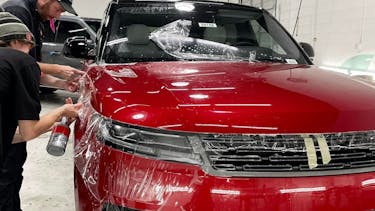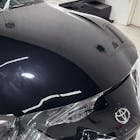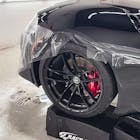What Happens to PPF After 15 Years?
After more than a decade on the road, discover how premium paint protection film holds up, when it’s time to replace it, and why quality matters.

Investing in Paint Protection Film (PPF) is an investment in protecting your vehicle — especially with XPEL PPF, the industry leader. But what about the long run? After 15 years, how does XPEL really hold up, and what can you expect? Let’s take a closer look at what happens to XPEL film after more than a decade on the road.
The Lifespan of XPEL PPF
XPEL sets the standard in the industry, and their films are designed to last. Most of us can expect 10–15 years of protection depending on how and where we drive. Thanks to XPEL’s advanced technology — like self-healing top coats and UV-resistant layers — the film resists yellowing, cracking, and fading far better than older generations of clear bra films.
That said, after 15 years, even XPEL begins to show its age.
Yellowing and Clarity
One of the reasons our shop exclusively uses XPEL is its superior resistance to discoloration. While cheaper films often yellow within a few years, XPEL is engineered with UV inhibitors that delay this process. Still, after 15 years in the sun, especially on lighter-colored cars, you may notice a faint haze or slight amber tint.
Edge Wear and Adhesion
The adhesive on XPEL is incredibly durable, but after 15 years of exposure to car washes, weather, and road grime, edges can begin to lift. Once this happens, dirt can creep under the film, making it more noticeable. While the protection is still there, the film isn’t as invisible as it once was.
To reduce the chance of this edge exposure, our highly-skilled technicians fully wrap all edges. An additional benefit of wrapped edges is that it eliminates any chance of gaps along. Most installers don’t offer this level of service because it’s more time-intensive and requires more material. It’s this level of service and attention to detail that has earned us the recognition as XPEl’s Top Washington Dealer of 2024.
Durability vs. Brittleness
One of XPEL’s standout features is flexibility — it conforms beautifully to curves and contours. But over time, prolonged exposure to heat and cold cycles can cause the film to harden. At around the 15-year mark, some panels may show tiny cracks or brittleness, especially in high-stress areas like hoods and fenders.
Protection Still in Place
Here’s the impressive part: even after 15 years, XPEL usually continues to provide real protection. Rock chips, scratches, and minor abrasions still hit the film instead of your paint. The trade-off, of course, is appearance. The film won’t look as flawless as it did when it was fresh, which is why many of us decide it’s time to refresh.
Time to Replace?
If your XPEL PPF is over 10 years old and showing signs of wear, it’s smart to consider replacement. The latest generation of XPEL films are clearer, more durable, and longer-lasting than ever before. So when we replace aging film, we’re not just restoring protection — we’re upgrading to better technology.
How XPEL Compares to Other Brands After 15 Years
Not all PPF ages the same. Here’s how XPEL stacks up against other brands over the long haul:
- 3M: Known for toughness, but older generations of 3M film were prone to yellowing and cracking well before the 15-year mark. XPEL’s UV resistance helps it stay clearer longer.
- STEK: STEK PPF is known for its excellent durability. It is a lifespan of up to 10 years.
- SunTek: Offers good clarity when new, but often lacks the same long-term durability. After a decade, SunTek films are more likely to show bubbling or edge lifting compared to XPEL.
- Generic / Off-Brand Films: Many of these films don’t make it past 5–7 years without major yellowing, cracking, or peeling. By comparison, XPEL is still protecting paint at 15 years, even if it shows some wear.
The bottom line? While all PPF eventually ages, XPEL consistently outlasts and outperforms, which is why it’s trusted on everything from daily drivers to exotic supercars.
Frequently Asked Questions About XPEL PPF Longevity
Will removing 15-year-old XPEL damage my paint?
No — if your film was professionally installed, removal should not damage your paint. In fact, XPEL’s adhesives are engineered to release cleanly, especially from factory paint. However, if your car was repainted at some point and the prep work wasn’t ideal, there’s a higher risk of pulling up paint during removal.
How much does it cost to replace XPEL after 15 years?
Replacement costs vary based on coverage. Thankfully, today’s films are even more advanced, so your new install will last longer and look better than older generations.
Can I extend the life of my XPEL film past 15 years?
Yes — regular maintenance helps. Keeping the film clean, applying ceramic coating on top, and avoiding harsh chemicals can extend clarity and longevity. That said, 15 years is about the upper limit for any PPF, even premium options like XPEL.
What’s the difference between XPEL ULTIMATE PLUS and older XPEL films?
ULTIMATE PLUS is the latest generation with improved clarity, stronger self-healing properties, and longer resistance to yellowing. Compared to films made 15 years ago, ULTIMATE PLUS offers a noticeable upgrade in both performance and appearance.
Schedule Your PPF Installation
At the 15-year mark, XPEL PPF has usually done exactly what you wanted it to do: protect your paint. It absorbed years of rock chips, scratches, and sun exposure so you vehicle’s finish didn’t have to. And while it may be ready for retirement, that’s actually a win — because replacing film is far easier (and far less expensive) than repainting panels.
Think of it as passing the baton. The old XPEL film did its job. Now it’s time for a fresh layer of ULTIMATE PLUS or STEALTH to carry on the protection.


